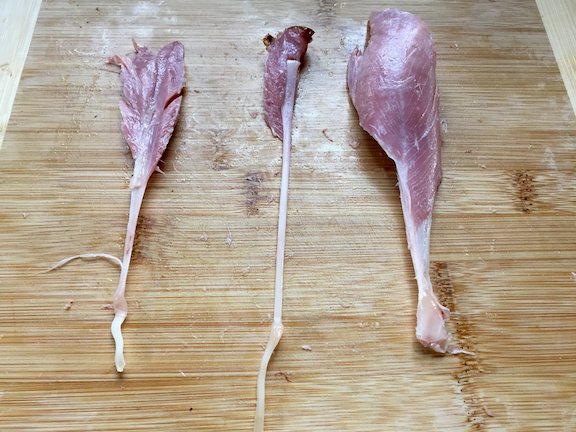Dissecting A Chicken Leg
A simple kitchen project allowing you to observe the bones and muscles in a leg similar to your own.
If you have ever carefully dissected a chicken wing, you may have noticed how similar the machinery is to a human arm, and you may have enjoyed seeing real examples of muscles and tendons in operation. Chicken legs are just as easy to buy as wings. Why can't we dissect a chicken leg and compare it to a human leg? In a way, chicken legs are even easier to study than wings, because they are larger, and the skin comes off much more easily. On the other hand, they don't show you a complete limb, because the feet aren't normally included. (However, sometimes you can buy the feet separately, and chicken feet make a great analog to the human hand.)
Supermarkets often sell chicken legs as “leg quarters,” which consist of a thigh and drumstick still in one piece. If the foot were still attached, you might notice the superficial resemblance to a human lower limb. We have a thigh, a lower leg, and a foot, and so does a chicken...except that we call the lower leg of a chicken the “drumstick.”
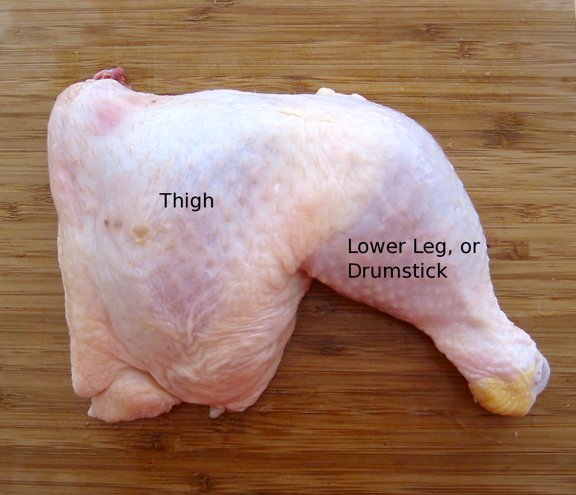
As we did with the wing, we need to start by removing the skin so that we can see the muscles underneath. Fortunately, the skin comes off of a leg much more easily than from a wing. You don't even need scissors. You can reach inside the hip end with your fingers and pry the skin free from the underlying tissue, then gradually peel the skin inside out off of the ankle end, like taking off a sock. You will find only one place where the skin is hard to remove — around the “ankle.” This is what a skinned leg looks like:
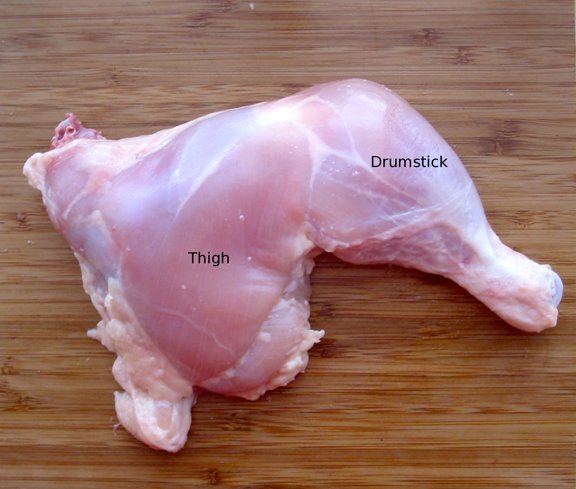
What are all of these muscles for? The human arm has a biceps muscle on the front and a triceps muscle on the back, and these muscles are responsible for folding (flexing) and opening (extending) the elbow joint. We can see both of these muscles from the outside as large lumps. We have muscles on the top and bottom of our thigh as well (the quadriceps and the hamstring muscles), and these are responsible for folding and opening the knee joint...but these are muscle groups. They are made of several muscles bundled together, and it is harder to point to individual muscles from the outside. In the chicken, it might be fun to see if you can identify the rectus femoris and the vastus lateralis, single muscles among the quadriceps that straighten the knee. But if time is short, you can just notice that there are groups of muscles that open and close the knee, like the quadriceps and hamstrings in human beings.
The drumstick is more interesting. If you've ever played with chicken feet, you may have noticed how chicken feet (and presumably human hands as well) work like puppets. They are moved by a bunch of strings that are pulled from the outside. But what is responsible for pulling on the tendons? Where is the “puppetmaster”? In a chicken wing, the muscles in the “forearm” pull on tendons to make the wing tip move. In your own arm, you can see and feel the muscles in your forearm move whenever you do something with your hand. The bundle of muscles in your forearm is the “puppetmaster” that controls your hand by pulling on the tendons that run out to your fingers. In the same way, a chicken's drumstick must contain the bundle of muscles that pull on the tendons that move the chicken's foot. The chicken's drumsticks are the “puppetmasters” that control its feet, and by dissecting a drumstick, we can see a very nice example of such a muscle bundle.
Unlike the chicken wing muscles, the muscles in the drumstick are relatively easy to pry apart from one another and examine separately. If you start from the ankle, you might be able to produce something like this:
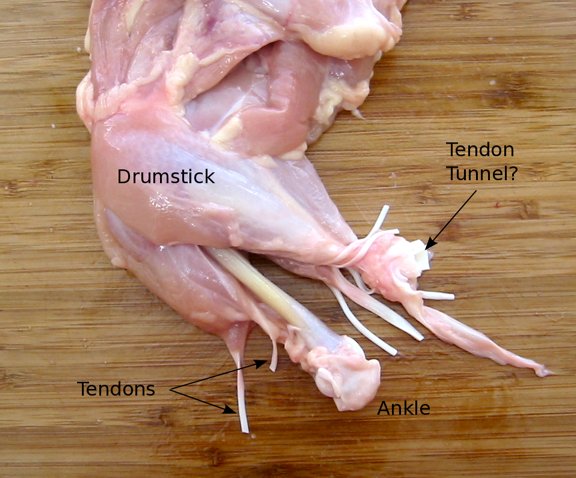
There is a tough band of cartilaginous material around the ankle, through which the tendons run. (Or at least they used to, before you removed them.) If you examine this band closely, you may find the passages or “tunnels” through which the tendons ran. What do you suppose this band is for? Perhaps it helps to hold all the tendons neatly against the ankle, and helps them to slide smoothly back and forth without getting tangled? This band corresponds to the retinacula around human wrists and ankles, and the tendon tunnels are like the carpal tunnel in the human wrist.
If you cut this band and pull it away, and then gradually pry, squeeze, or pull apart the muscles, you should find that the drumstick is indeed constructed like a “puppetmaster,” with a bundle of muscles, each pulling on a “drawstring” that runs out to the foot and pulls the toes into different positions. The drumstick muscles are the engines that pull on the tendons and drive the motions of the chicken's foot, just as your forearm makes your hand move, and your lower leg makes your foot move.
I have read that, if you work carefully and pay close attention as you pull the muscles of the leg apart, you should be able to discover such minute things as blood vessels, nerves, and synovial bursae. However, I haven't had much luck finding these myself. (There are some tubes that are quite easy to notice, as they are filled with red blood. I believe these are veins, rather than arteries, because the arteries are muscular and allegedly contract upon death, squeezing the blood out of them...but I'm not at all positive about this. Are there any medical students or medical examiners out there who can confirm that in cadavers, veins are full and arteries are empty?)
When you are done studying the machinery of the chicken's leg, you can remove the muscles to get a better look at the skeleton. If you remove as much of the musculature as you can, trying to damage the bones and the ligaments as little as possible, you will discover the skeleton in a chicken leg:
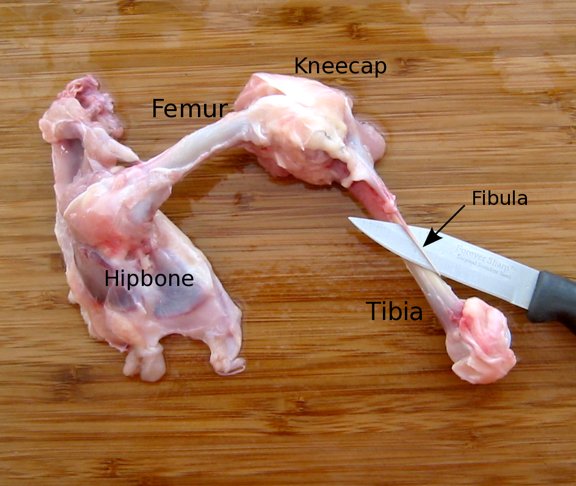
The chicken wing resembles a human arm in the way that it is constructed, and a chicken leg resembles a human leg in a similar way. And the resemblance is more than skin deep. It goes all the way to the bone. The thigh contains a single large bone, which we may as well call the femur. The lower leg contains a pair of long bones, one of which is large and strong (the tibia), and the other of which is thin and frail and stuck to the first (the fibula). In a human, the fibula is a secondary “helper” bone, but at least it is as long as the entire lower leg, and is stuck firmly to the tibia at both ends. In a chicken, the fibula is so meager that it doesn't even reach the ankle end. It is just a needle sticking down from the knee joint, and ending in the middle of the leg.
The resemblance continues if we examine the joints in more detail. The knee has a cartilaginous covering over the front resembling a kneecap. It also has vertical ligaments on the sides of the knee, and criss-cross ligaments inside. These ligaments definitely resemble the collateral ligaments, and cruciform or cruciate ligaments, in a human knee. The hip is a ball-and-socket joint consisting of the rounded upper end of the femur fitting into a socket in the hip bone. Several ligaments hold the hip together, including a ligament within the socket, helping to hold the head of the femur inside the socket (the ligamentum teres).
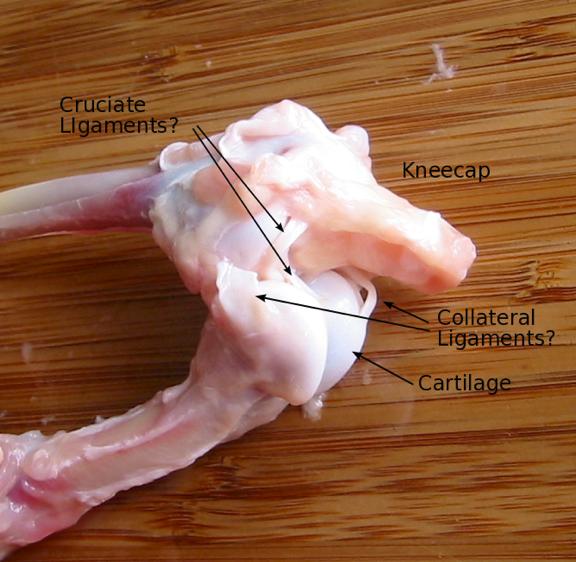
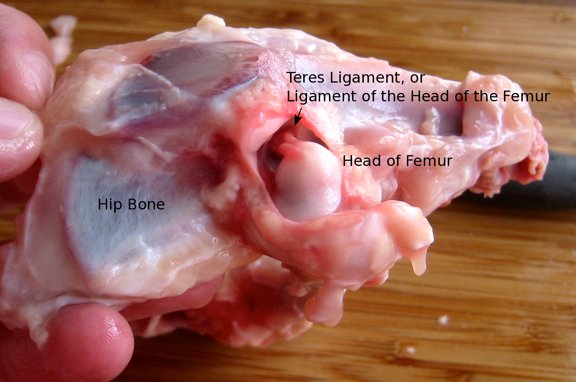
To produce a chicken quarter, you have to saw the hipbone from the rest of the body. Sometimes (usually?) this cut goes through the spine. If this is so, your chicken quarter might also give a nice view of the inside of a spine.

Postscript: Turkey Drumsticks
Sometimes my supermarket sells smoked turkey drumsticks. I like buying them because they make very flavorful broth, but I also realized that they might make a good supplemental dissection to the chicken leg. Like a chicken drumstick and a human lower leg, a turkey drumstick is composed of a bundle of muscles that taper into an array of parallel tendons that run into the foot to control it, in the same way that an array of strings can manipulate a puppet. And you can see this arrangement very clearly by carefully pulling apart a turkey drumstick.
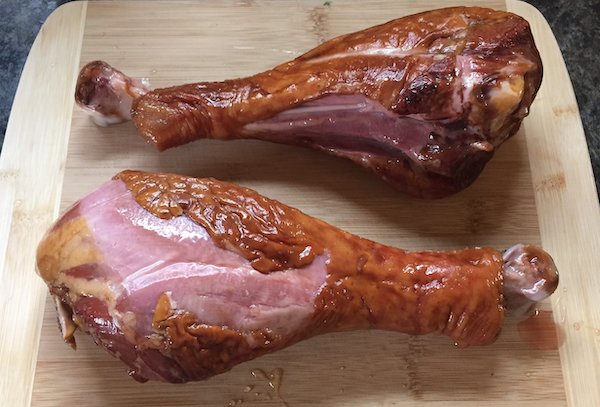
I tried to start as in the chicken leg dissection, by removing the skin to expose the muscles. However, the skin of the smoked drumstick would not peel up nearly as easily as it did from a raw chicken leg. So I gave up on skinning the drumstick, and I just snipped the retinacula around the ankles in one or two places and started prying all of the muscles apart from each other as gently as I could. Because it was larger than the chicken drumstick, and perhaps also because it was smoked, I thought it was actually easier to pry the muscles apart from each other without damaging them (much).
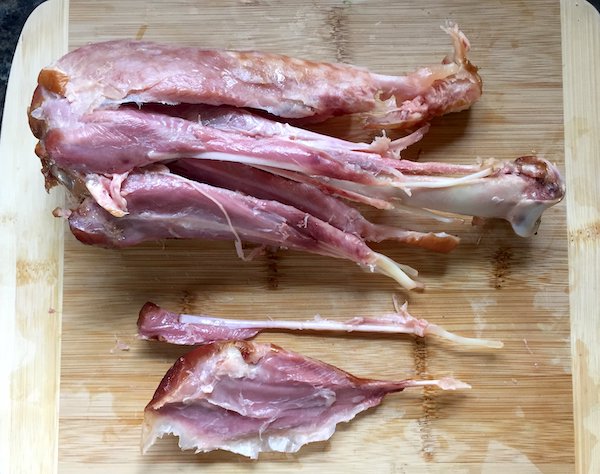
If you closely examine the ankle end of the drumstick, you might be able to notice a couple of things that weren't as obvious in the smaller chicken drumstick. On one side of the drumstick, I could easily see numerous small tendon tunnels in the end of the drumstick.

On the other side, there was one especially obvious large tendon, presumably the turkey's Achilles tendon, running alongside the edge of the bone. This one is so large, there is even a groove in the bone in which the tendon rests and slides. (This is a particularly large example, but bones often have contours in them to accommodate tendons or blood vessels or other neighboring bits of fabric.)
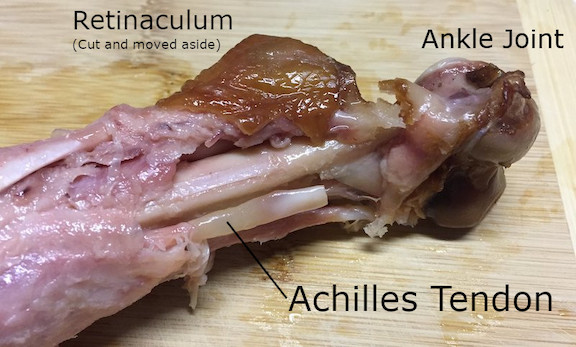
With the dried and relatively large muscles of the turkey drumstick, you can also study the structure of muscles themselves in a little more detail. For example, you might notice the different ways in which limb muscles are attached to bones at their inner (proximal) and outer (distal) ends. At the inner end, they tend to be sewn to the bone very closely and tightly across a broad area, and often in more than one place, giving solid anchor points for the muscle closer to the body. (The fact that limb muscles often have several anchor points is why so many limb muscles have “ceps” in their names. The names “biceps,” “triceps,” and “quadriceps” all refer to how many “heads” or anchors they have.) At the outer end, limb muscles tend to taper into a single tough tendon that can run through fabric and possibly through tunnels or around corners. This tendon ultimately reaches another bone, and the job of the muscle is to move the outer bone by pulling on the tendon. The official name for the upper anchor is the “origin” of the muscle, and the name for the final attachment point of the tendon is the “insertion” of the muscle.
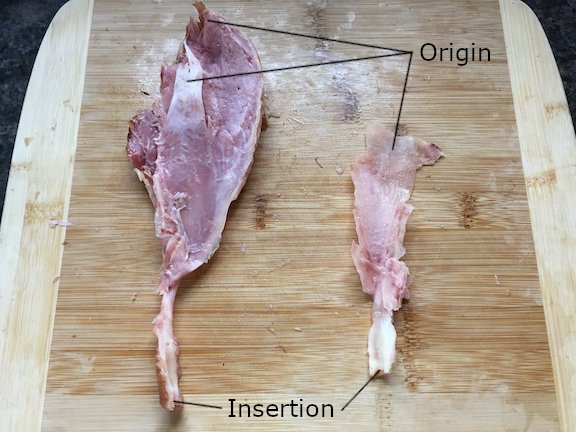
If you performed the chicken wing dissection, and you tried pulling on the individual muscles to see what they do, you may have noticed that a tiny motion of the muscle could produce a much larger motion of the wing tip. Individual muscles generally can't pull very far. But you may have noticed that limb muscles are often attached very near to the joint (i.e. the insertion point is close to the pivot point of the distal bone). This allows the muscle to employ “reverse leverage” to magnify the motion in the outer bone, in a manner similar to catapults, or to fishermen casting lures. Muscles can use leverage to swing limbs in large arcs, obeying the same principles as any other levers.
And this is true not only of whole muscles, but also of the fibers within the muscles themselves. In some situations, muscles can gain leverage by having the fibers pull at an angle, either from both sides or from one side only. This is the principle behind “feather-like” or pennate muscles, and you can see find several clear examples of pennate muscles in a turkey drumstick.
